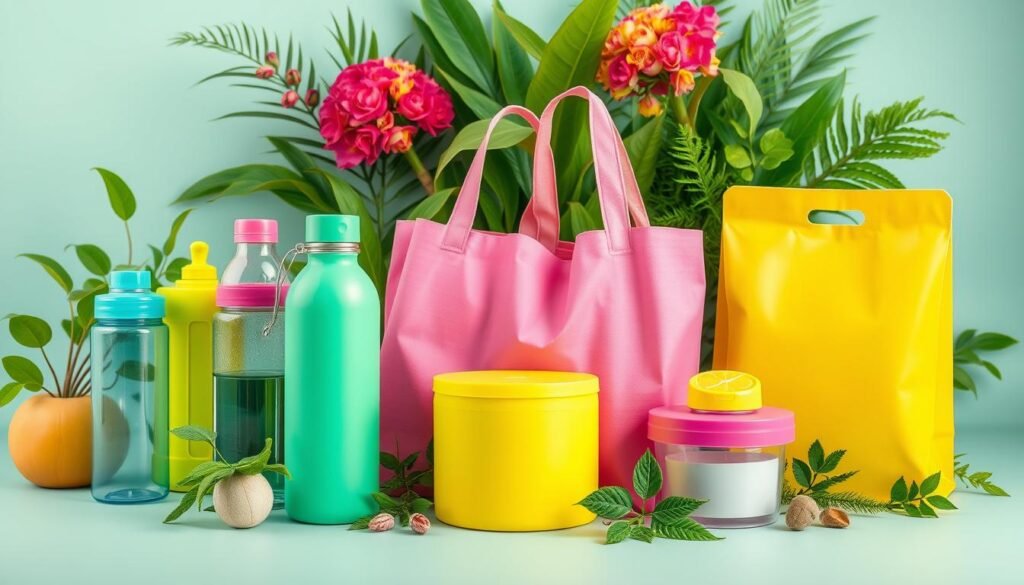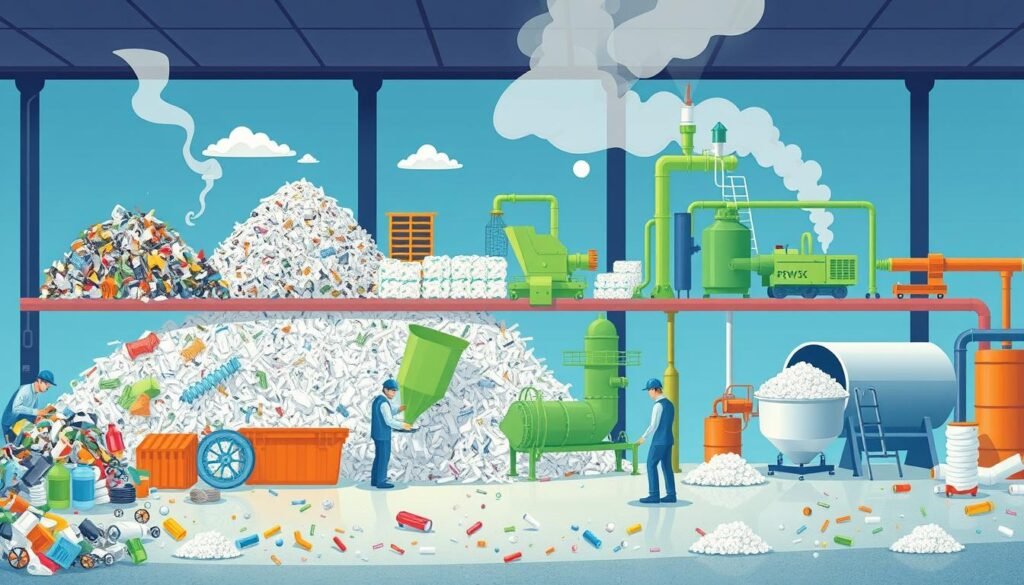We’re leaders in high-tech recycling solutions. We understand how important it is to know about plastic recycling signs. These symbols are on almost all plastic items. They contain resin identification codes. These codes help business owners and professionals use plastic recycling processes fully.
PET or PETE (polyethylene terephthalate) is everywhere in recycling. It’s marked by the number 1. PETE is important because it can be turned into new items. It’s used from water bottles to food packaging. Sadly, only about 20% of PETE is recycled. There’s a lot of opportunity to do better.
The symbol for HDPE (high-density polyethylene) is the number 2. It’s another important recyclable material. Items like milk jugs and shampoo bottles are made from HDPE. It’s strong and doesn’t easily leak chemicals. HDPE can be reused up to ten times. This makes it key for a sustainable future.
Our goal is to offer dependable recycling machines. We have lots of experience and care about the environment. We aim to explain recycling symbols clearly. By doing this, we help make industries both sustainable and efficient.
An Overview of Plastic Recycling Signs
We know how critical it is to understand the resin identification coding system. It’s key for recycling and helping the environment. Created in 1988, this system shows how to recycle and reuse different plastics.
Understanding the Resin Identification Coding System
The resin identification coding system started to help recycle plastics better. It uses symbols with numbers to show the type of polymer. This makes sorting for recycling easier and helps people know what type of plastic they have.
The U.S. uses seven main codes, each showing how recyclable a plastic is and its environmental impact. For instance, PET (code 1) is easy to recycle and is in stuff like water bottles. However, PVC (code 3), used in things like pipes, is hard to recycle because of its chemicals.
The Evolution of Recycling Symbols Since 1988
The recycling symbol, created by Gary Anderson in 1970, has evolved a lot. It’s become standard worldwide, including the European Union adding resin codes to packaging. This standardization is a big step for waste management.
But, we’re still facing hurdles. A small amount of all plastic gets recycled. Efforts like the Zero Plastic Inside logo and Nestlé’s Negative List are key. They raise awareness and push for less use of hard-to-recycle plastics.
Heading into the future, knowing these symbols and their history is crucial for better recycling. With some states now banning non-recyclable plastics, like polystyrene, we’re gaining momentum towards better recycling rules that are good for the planet.
| Code | Type of Plastic | Recyclability | Common Uses |
|---|---|---|---|
| 1 (PETE) | Polyethylene Terephthalate | Highly Recyclable | Beverage bottles, Food containers |
| 3 (PVC) | Polyvinyl Chloride | Challenging to Recycle | Pipes, Medical equipment, Siding |
| 6 (PS) | Polystyrene | Often Non-recyclable | Disposable cutlery, CD cases |
| 7 (Other) | Various other plastics | Typically Not Recyclable | Multi-material packaging |
Learning more about plastic packaging and recycling codes helps with proper waste management. It greatly impacts how companies around the world think about sustainability. It’s a big change for environmental care.
The Most Recyclable Plastics: PETE and HDPE
We are committed to environmental responsibility. We focus on PETE and HDPE because they are key to recycling and reuse. These materials help us lower our ecological footprints. They also support sustainable packaging.
Learning about these materials can help industries and people move towards a greener future.
Common Uses and Recycling Pathways for PETE (No. 1)
Polyethylene Terephthalate, or PETE, stands out for its recycling abilities. It is often used for beverage and food containers. PETE is clear and protects against moisture and air, which keeps products fresh. PETE recycling lets us make new bottles and even polyester for clothes.
HDPE (No. 2) Products and Their Recyclability
High-Density Polyethylene, or HDPE, is known for being strong and useful. It’s in shampoo bottles, milk jugs, and detergent containers. HDPE can be recycled many times. It can handle different chemicals without risk, keeping items safe. Recycling HDPE can create plastic lumber, outdoor furniture, and bins. This showcases its role in sustainable packaging.

| Plastic Type | Reusability Rating | Recyclability Rating | Toxin Leaching |
|---|---|---|---|
| PETE | ★☆☆☆☆ | ★★★★☆ | ★★☆☆☆ |
| HDPE | ★★★★☆ | ★★☆☆☆ | ★☆☆☆☆ |
We aim to boost PETE recycling and HDPE reuse. Teaching about proper disposal and cleaning of recyclables is key. This maintains quality in recycled products and upholds environmental responsibility.
A Closer Look at PVC and Vinyl Recycling Challenges
In the world of industrial materials, Polyvinyl Chloride (PVC) ranks as the third top-produced thermoplastic. It’s used in construction, medical equipment, and cars because of its strength and versatility. Yet, the PVC recycling difficulties are big due to its complex makeup and the pollution from chemical leaching.

In Europe, around 70% of PVC goes into building materials like window frames and pipes. But, recycling rates for PVC are very low. This is because PVC has chlorine and harmful additives, making vinyl processing hard. This issue harms sustainable manufacturing, as many studies show.
PVC is used in many ways, such as in car cables and building water pipes. So, overcoming recycling hurdles is key. Let’s look at how PVC is used across industries and its recycling challenges:
| Industry | PVC Usage | Recycling Process Difficulty | Improvement Measures |
|---|---|---|---|
| Construction | Window profiles, pipes | High due to additives and composites | Standardize formulations for easier separation |
| Medical | Biocompatible items, tubing | Medium, monitoring required due to health implications | Increase non-PVC alternatives |
| Automotive | Insulation, hoses | High, diverse additives used | Develop recycling-friendly additives |
| Consumer Products | Toys, credit cards | Low, materials often mixed | Better consumer awareness and collection systems |
Technology and rules may help sustainable manufacturing, but everyone needs to work together. PVC items often end up in the trash, not recycling centers. The Vinyl Institute starting a recycling grant in 2023 is a good step towards better PVC recycling technologies.
Facing PVC recycling challenges head-on is crucial. By following circular economy principles and focusing on innovation, we can recycle PVC successfully. This not only saves resources but also leads to a greener future. It reduces the negative impacts of this common material.
Deciphering Low-Density Polyethylene: LDPE Items
Our insights show how important low-density polyethylene (LDPE) is. It’s mostly seen in plastic waste, with a symbol of #4. Around 56% of all plastic waste is LDPE, and homes are the source of about 75% of this. But, it’s hard to recycle LDPE because most places don’t pick it up at the curb. This makes a big difference on its effect on the environment.
Nowadays, more places are starting to recycle LDPE, but it’s still not a lot. Most of this recycling happens at special drop-off spots in stores. At these spots, LDPE is turned into new things like compost bins and envelopes for mailing. This shows a small but important move toward being more eco-friendly.
Our company makes advanced recycling machines and is working to make recycling LDPE better. We want to help the planet by finding new ways to recycle. Our goal is to create trustworthy recycling solutions. These solutions support our customers and care for the environment at the same time.
